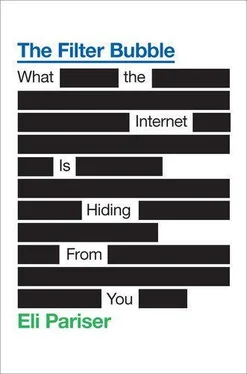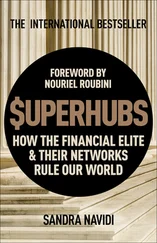The push for relevance gave rise to today’s Internet giants, and it is motivating businesses to accumulate ever more data about us and to invisibly tailor our online experiences on that basis. It’s changing the fabric of the Web. But as we’ll see, the consequences of personalization for how we consume news, make political decisions, and even how we think will be even more dramatic.
2
The User Is the Content
Everything which bars freedom and fullness of communication sets up barriers that divide human beings into sets and cliques, into antagonistic sects and factions, and thereby undermines the democratic way of life.
—John Dewey
The technology will be so good, it will be very hard for people to watch or consume something that has not in some sense been tailored for them.
—Eric Schmidt, Google CEO
Microsoft Building 1 in Mountain View, California, is a long, low, gunmetal gray hangar, and if it weren’t for the cars buzzing by behind it on Highway 101, you’d almost be able to hear the whine of ultrasonic security. On this Saturday in 2010, the vast expanses of parking lot were empty except for a few dozen BMWs and Volvos. A cluster of scrubby pine trees bent in the gusty wind.
Inside, the concrete-floored hallways were crawling with CEOs in jeans and blazers trading business cards over coffee and swapping stories about deals. Most hadn’t come far; the startups they represented were based nearby. Hovering over the cheese spread was a group of executives from data firms like Acxiom and Experian who had flown in from Arkansas and New York the night before. With fewer than a hundred people in attendance, the Social Graph Symposium nonetheless included the leaders and luminaries of the targeted-marketing field.
A bell rang, the group filed into breakout rooms, and one of the conversations quickly turned to the battle to “monetize content.” The picture, the group agreed, didn’t look good for newspapers.
The contours of the situation were clear to anyone paying attention: The Internet had delivered a number of mortal blows to the newspaper business model, any one of which might be fatal. Craigslist had made classified advertisements free, and $18 billion in revenue went poof. Nor was online advertising picking up the slack. An advertising pioneer once famously said, “Half the money I spend on advertising is wasted—I just don’t know which half.” But the Internet turned that logic on its head—with click-through rates and other metrics, businesses suddenly knew exactly which half of their money went to waste. And when ads didn’t work as well as the industry had promised, advertising budgets were cut accordingly. Meanwhile, bloggers and freelance journalists started to package and produce news content for free, which pressured the papers to do the same online.
But what most interested the crowd in the room was the fact that the entire premise on which the news business had been built was changing, and the publishers weren’t even paying attention.
The New York Times had traditionally been able to command high ad rates because advertisers knew it attracted a premium audience—the wealthy opinion-making elite of New York and beyond. In fact, the publisher had a near monopoly on reaching that group—there were only a few other outlets that provided a direct feed into their homes (and out of their pocketbooks).
Now all that was changing. One executive in the marketing session was especially blunt. “The publishers are losing,” he said, “and they will lose, because they just don’t get it.”
Instead of taking out expensive advertisements in the New York Times, it was now possible to track that elite cosmopolitan readership using data acquired from Acxiom or BlueKai. This was, to say the least, a game changer in the business of news. Advertisers no longer needed to pay the New York Times to reach Times readers: they could target them wherever they went online. The era where you had to develop premium content to get premium audiences, in other words, was coming to a close.
The numbers said it all. In 2003, publishers of articles and videos online received most of each dollar advertisers spent on their sites. Now, in 2010, they only received $.20. The difference was moving to the people who had the data—many of whom were in attendance at Mountain View. A PowerPoint presentation circulating in the industry called out the significance of this change succinctly, describing how “premium publishers [were] losing a key advantage” because advertisers can now target premium audiences in “other, cheaper places.” The take-home message was clear: Users, not sites, were now the focus.
Unless newspapers could think of themselves as behavioral data companies with a mission of churning out information about their readers’ preferences—unless, in other words, they could adapt themselves to the personalized, filter-bubble world—they were sunk.
NEWS SHAPES OURsense of the world, of what’s important, of the scale and color and character of our problems. More important, it provides the foundation of shared experience and shared knowledge on which democracy is built. Unless we understand the big problems our societies face, we can’t act together to fix them. Walter Lippmann, the father of modern journalism, put it more eloquently: “All that the sharpest critics of democracy have alleged is true, if there is no steady supply of trustworthy and relevant news. Incompetence and aimlessness, corruption and disloyalty, panic and ultimate disaster must come to any people which is denied an assured access to the facts.”
If news matters, newspapers matter, because their journalists write most of it. Although the majority of Americans get their news from local and national TV broadcasts, most of the actual reporting and story generation happens in newspaper newsrooms. They’re the core creators of the news economy. Even in 2010, blogs remain incredibly reliant on them: according to Pew Research Center’s Project for Excellence in Journalism, 99 percent of the stories linked to in blog posts come from newspapers and broadcast networks, and the New York Times and Washington Post alone account for nearly 50 percent of all blog links. While rising in importance and influence, net-native media still mostly lack the capacity to shape public life that these papers and a few other outlets like the BBC and CNN have.
But the shift is coming. The forces unleashed by the Internet are driving a radical transformation in who produces news and how they do it. Whereas once you had to buy the whole paper to get the sports section, now you can go to a sports-only Web site with enough new content each day to fill ten papers. Whereas once only those who could buy ink by the barrel could reach an audience of millions, now anyone with a laptop and a fresh idea can.
If we look carefully, we can begin to project the outline of the new constellation that’s emerging. This much we know:
• The cost of producing and distributing media of all kinds—words, images, video, and audio streams—will continue to fall closer and closer to zero.
• As a result, we’ll be deluged with choices of what to pay attention to—and we’ll continue to suffer from “attention crash.” This makes curators all the more important. We’ll rely ever more heavily on human and software curators to determine what news we should consume.
• Professional human editors are expensive, and code is cheap. Increasingly, we’ll rely on a mix of nonprofessional editors (our friends and colleagues) and software code to figure out what to watch, read, and see. This code will draw heavily on the power of personalization and displace professional human editors.
Читать дальше











